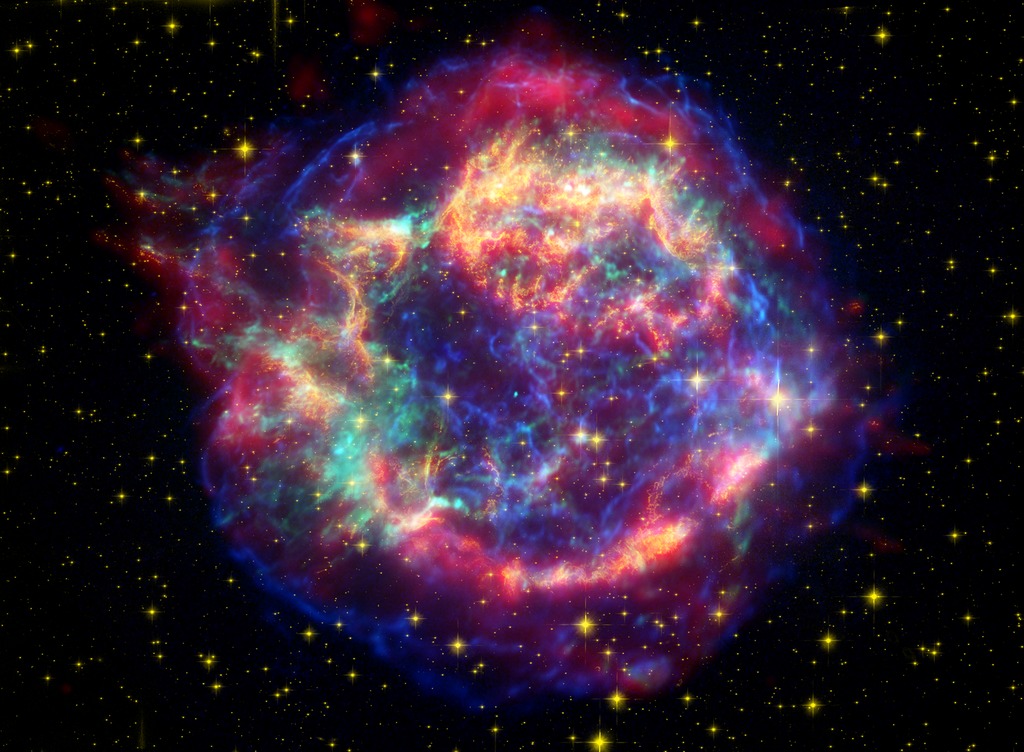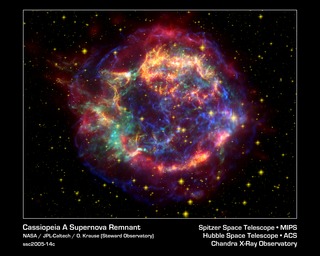
Credit: NASA/JPL-Caltech/O. Krause (Steward Observatory)
Observation • June 9th, 2005 • ssc2005-14c1
ssc2005-14c1
This stunning multi-mission picture shows off the many sides of the supernova remnant Cassiopeia A. It is made up of images taken by three of NASA's Great Observatories, using three different wavebands of light. Infrared data from the Spitzer Space Telescope are colored red; visible data from the Hubble Space Telescope are yellow; and X-ray data from the Chandra X-ray Observatory are green and blue.
Located 10,000 light-years away in the northern constellation Cassiopeia, Cassiopeia A is the remnant of a once massive star that died in a violent supernova explosion seen on Earth 325 years ago. It consists of a dead star, called a neutron star, and a surrounding shell of material that was blasted off as the star died. This remnant marks the most recent supernova in our Milky Way galaxy, and is one of the most studied objects in the sky.
Each Great Observatory highlights different characteristics of this celestial orb. While Spitzer reveals warm dust in the outer shell about a few hundred degrees Kelvin (80 degrees Fahrenheit) in temperature, Hubble sees the delicate filamentary structures of hot gases about 10,000 degrees Kelvin (18,000 degrees Fahrenheit). Chandra probes unimaginably hot gases, up to about 10 million degrees Kelvin (18 million degrees Fahrenheit). These extremely hot gases were created when ejected material from Cassiopeia A smashed into surrounding gas and dust. Chandra can also see Cassiopeia A's neutron star (turquoise dot at center of shell).
Blue Chandra data were acquired using broadband X-rays (low to high energies); green Chandra data correspond to intermediate energy X-rays; yellow Hubble data were taken using a 900 nanometer-wavelength filter, and red Spitzer data are from the telescope's 24-micron detector.
About the Object
- Name
- Cassiopeia A • Cas A
- Type
- Nebula > Type > Supernova Remnant
- Nebula > Appearance > Reflection > Light Echo
- Distance
- 11,000 Light Years
Color Mapping
| Band | Wavelength | Telescope |
| X-ray | 5.0 keV | Chandra ACIS |
| X-ray | 0.7 keV | Chandra ACIS |
| Optical | 656 nm | Hubble WFPC2 |
| Infrared | 8.0 µm | Spitzer IRAC |
Astrometrics
- Position (J2000)
- RA =23h 23m 27.8s
- Dec = 58° 48' 57.6"
- Field of View
- 8.7 x 6.4 arcminutes
- Orientation
- North is 1.0° right of vertical





